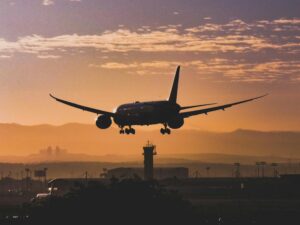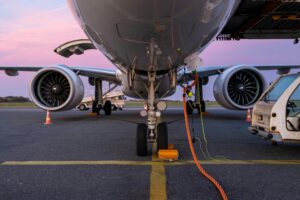European airlines are sounding alarm bells over looming sustainable aviation fuel (SAF) mandates, but African carriers might have discovered a powerful solution that their European counterparts lack. While aviation giants like Lufthansa and Air France-KLM warn that meeting the European Union’s 2030 SAF requirements seems increasingly unrealistic, Africa’s emerging Single African Air Transport Market (SAATM) offers a strategic advantage that could transform a seemingly impossible challenge into an opportunity for the continent’s aviation sector.
The stakes couldn’t be higher. European carriers face a mandatory 6% SAF blend by 2030 – a requirement that has CEOs publicly expressing doubt about feasibility. Meanwhile, the global aviation industry is struggling with a fundamental supply-demand mismatch: SAF production currently represents less than 0.1% of global jet fuel consumption, yet ambitious targets would require ramping to 65% by 2050.
Why European Airlines Are Panicking
The anxiety from European airlines stems from cold, hard reality. SAF currently costs 3-5 times more than conventional jet fuel, and production capacity remains severely constrained. Airbus CEO Guillaume Faury recently expressed skepticism about the industry meeting its net-zero emissions goal by 2050, suggesting more time might be needed. This admission from one of aviation’s most powerful executives underscores the magnitude of the challenge.
European carriers face a triple threat: limited SAF availability, prohibitive costs, and increasing regulatory pressure. Each airline must navigate these challenges independently, creating a competitive scramble for scarce sustainable resources that drives prices even higher. The economic equation simply doesn’t balance.
African airlines face these same fundamental challenges – but with a crucial difference.
SAATM: Africa’s Collective Bargaining Power
The Single African Air Transport Market represents the most ambitious aviation integration project since the European Union’s own common aviation market. Created through the Yamoussoukro Decision, SAATM aims to unify Africa’s fragmented air transport regulations and create a single aviation market across the continent. While primarily focused on liberalization and connectivity, SAATM’s structure creates a powerful platform for addressing sustainability mandates collectively.
What makes SAATM particularly valuable in the face of global SAF mandates is its ability to transform individual vulnerability into collective strength. Rather than each African airline competing against others for limited SAF resources, SAATM creates mechanisms for joint approaches to several critical challenges:
Pooled Purchasing Power
Think of SAATM as enabling an aviation purchasing consortium. With 34 signatory states representing the majority of Africa’s aviation market, SAATM members could potentially coordinate SAF procurement strategies, creating economies of scale that individual carriers cannot achieve.
“Combined procurement strategies through SAATM could significantly reduce the cost premium African airlines would pay for sustainable aviation fuels,” says Dr. Elijah Chingosho, former Secretary General of the African Airlines Association. “Instead of dozens of separate negotiations with SAF suppliers, a coordinated approach could strengthen negotiating positions while ensuring more equitable distribution.”
This approach transforms the equation fundamentally. European airlines – even the largest ones – represent just their own fuel volumes in procurement discussions. A unified African approach under SAATM could represent continent-wide demand, creating leverage that individual carriers simply cannot match.
Strategic Infrastructure Development
SAF production requires substantial infrastructure investment – another area where SAATM offers African aviation an advantage. Rather than duplicating SAF production facilities across multiple countries, SAATM creates a framework for strategic, coordinated development of production capacity.
African nations rich in biofuel feedstocks could develop specialized production capabilities serving multiple markets. Countries with advanced refining capacity could focus on processing. The entire sustainable aviation fuel supply chain could be optimized across the continent, reducing redundancy and maximizing efficiency.
Ethiopia, Kenya and South Africa have already begun exploring coordinated approaches to aviation sustainability. Ethiopian Airlines CEO Mesfin Tasew recently noted that “regional cooperation fundamentally changes the economics of sustainable aviation. What seems impossible for one airline becomes achievable when approached collectively.”
Policy Harmonization and Regulatory Voice
Perhaps most importantly, SAATM gives African aviation a unified voice in global sustainability discussions. Rather than accepting mandates designed primarily for European or North American markets, African nations can develop approaches suited to their unique circumstances and priorities.
SAATM creates a framework for developing Africa-specific SAF regulations and implementation timelines that balance environmental aspirations with economic realities. This coordinated approach prevents regulatory fragmentation that would make compliance even more challenging for airlines operating across multiple African countries.
It also strengthens Africa’s position in international aviation environmental negotiations. A unified SAATM position carries substantially more influence than individual nations advocating separately, potentially allowing Africa to shape global aviation sustainability frameworks rather than simply adapting to them.
Beyond SAF: SAATM and Alternative Propulsion
While sustainable aviation fuel represents the most immediate pathway to reducing aviation emissions, longer-term solutions include hydrogen and electric propulsion – areas where SAATM again offers strategic advantages.
Airbus is advancing its ZEROe hydrogen aircraft program, aiming for commercial introduction by the late 2030s. Such aircraft will require specialized infrastructure and operational modifications. Under SAATM, African nations could coordinate hydrogen infrastructure development across key aviation hubs, creating efficient corridors for future zero-emission aircraft.
Similarly, electric and hybrid-electric aircraft suited for shorter regional routes could be deployed strategically across the continent. SAATM’s regulatory harmonization would prevent the complications of different technical standards and certification requirements that would otherwise create barriers to adoption.
Implementation Challenges Remain
SAATM’s potential as a solution to aviation sustainability challenges depends on implementation effectiveness. Despite being signed by 34 countries, practical progress on SAATM’s core liberalization goals has been uneven. Political resistance, protectionist concerns, and implementation capacity constraints have slowed momentum in some regions.
These same challenges could affect SAATM’s effectiveness as a platform for addressing SAF mandates. Competing national priorities, different perspectives on environmental priorities, and varying levels of financial capability all present potential complications.
Progress will require dedicated focus from aviation stakeholders across the continent. African airlines, civil aviation authorities, and regional economic communities must explicitly recognize SAATM’s potential role in sustainability compliance and develop specific mechanisms for cooperation in this domain.
A Continental Opportunity
While European airlines continue struggling individually against seemingly impossible sustainable fuel mandates, Africa has a unique opportunity to demonstrate how continental cooperation can transform environmental challenges into strategic advantages.
SAATM was conceived primarily as a market liberalization mechanism, but its potential extends far beyond simply increasing connectivity. In the face of global aviation’s sustainability transformation, SAATM may prove to be Africa’s most powerful tool for ensuring its airlines not only survive but thrive.
The alternative – each African carrier attempting to address SAF mandates independently – would likely prove economically unsustainable for many operators, potentially reducing connectivity across a continent that desperately needs more air service, not less.
By leveraging SAATM to develop coordinated approaches to SAF procurement, production and regulation, African aviation can potentially accomplish what European airlines are finding increasingly difficult: meeting global sustainability requirements while maintaining economic viability.
The approach offers lessons for other regions as well. As Airbus CEO Guillaume Faury emphasized when criticizing flight bans and punitive aviation taxes, maintaining connectivity while addressing environmental concerns requires thoughtful, cooperative approaches rather than fragmented regulations.
Africa’s SAATM might just prove to be the model that demonstrates how regional cooperation transforms seemingly impossible sustainability mandates into achievable realities. The continent often viewed as aviation’s final frontier could become its sustainability pioneer – showing established markets that when it comes to addressing aviation’s environmental challenges, unity creates possibilities that competition cannot match.
Disclaimer: The insights shared in this article are for information purposes only and do not constitute strategic advice. Aviation markets and circumstances vary, and decisions should be based on your organisation’s specific context. For tailored consultancy and guidance, please contact info@avaerocapital.com.




